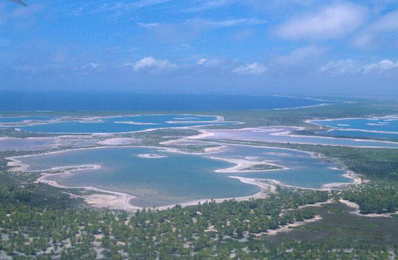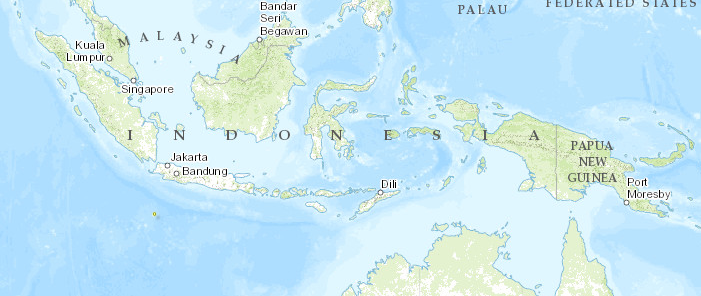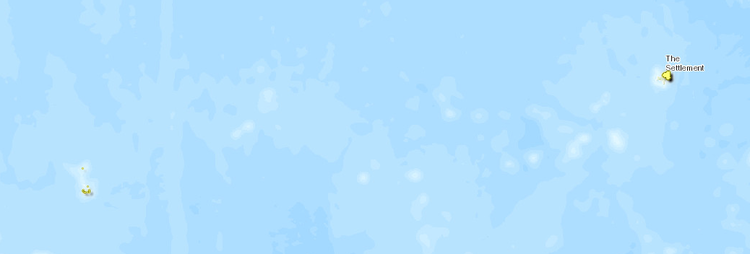Christmas and Cocos Islands tropical forests
Introduction Christmas Island and the uninhabited North Keeling Island of the Cocos group both maintain significant native tropical (Christmas and Cocos Islands tropical forests) forest cover, composed of dissimilar assemblages of Indo-Pacific and Melanesian tree species. While forests on Christmas Island are similar to those found on other nearby Indonesian high volcanic islands, they are unique in the degree to which their composition and recruitment are controlled by the huge numbers of terrestrial red crabs (Gecarcoidea natalis) present on the island. Despite its small size, Christmas Island supports a large number of endemic species and subspecies including one of the rarest owls in the world, the Christmas Island hawk owl (Ninox natalis). Phosphate mining of extensive bird guano deposits has resulted in the destruction of some of the island’s native habitat; however, the inclusion of 63% of the island in a national park should ensure the protection of this unique forest. The Cocos Islands are probably best described not by their uniqueness, but by the degree to which they typify atoll ecosystems throughout the Indian and Pacific Oceans. Indeed, a visit to these islands by Charles Darwin in 1836 provided the basis for his theory on coral reef and atoll development that still holds today.
Location and General Description
Christmas Island is located 360 kilometers (km) south of Jakarta, Indonesia at 100 S and 1050E. The 137 km2 island is the peak of an ancient volcano rising 5000 meters (m) from the ocean floor. While it’s volcanic origin is mostly hidden under a thick crust of porous coralline limestone and phosphate-rich soil, the underlying basalt is exposed in a few places allowing the accumulation of surface water. As sea levels have changed, limestone has been deposited and eroded resulting in a series of stepped terraces rising to an inland plateau 250-300 m high. Undercut cliffs dominate much of the island’s coastline except for a few beaches around the northeast. The climate is tropical with temperatures between 23-290 C and a constant humidity of 80-90%. Over 2000 millimeters (mm) of rain falls on the island, mostly during the northwest monsoon between December to April.
Christmas Island forests are dominated by Indo-Malaysian and Melanesian tree species that form a dense evergreen canopy supporting a diverse epiphyte community, but with little understory vegetation. During the dry season some deciduous species drop their foliage exposing the understory to more light. In areas with deep soil, the canopy reaches 30-40 m with emergents growing to 50 m. The most common tree canopy species are: Planchonella nitida, Syzygium nervosum, Tristiropsis acutangula, Inocarpus fagifer, and Hernandia ovigera. The understory is dominated by two endemic species: the palm Arenga listeri and the tree-like Pandanus elatus. The forest floor is almost bare of leaf litter, seeds, or seedlings because they are quickly consumed by the approximately 100 million red crabs (Gecarcoidea natalis) found in the forest. In total there are 237 native and 174 introduced plant species on the island, and most of the introduced species are restricted to disturbed sites.
The Cocos Islands are located 1000 km southwest of western Java, Indonesia at 120 S and 960 E. The ecoregion consists of two separate island groups: 1.1 km2 North Keeling Island is about 25 km north of the main horseshoe-shaped atoll of 30 islands. Each island group sits atop a volcanic seamount in the Vening Meinesz chain. As the seamounts have subsided downward, reef-building has maintained land near the sea surface such that the coral rock is built up 0.5-1.0 km thick over the igneous base. However, coral growth has not always kept pace with changes in sea level and all land in the islands was submerged as recently as 4000 BP. Currently, the highest point is atop a 9 m sand dune and [[soil]s] are based mostly on coral, guano, and pumice washed ashore after volcanic eruptions nearby. The southern islands encircle a large lagoon that ranges in depth from 1 m in the southern end to 15 m in the north. The islands are tropical with mean daily temperatures ranging from 26-280 C. Southeast trade winds are fairly constant with an average rainfall of over 2100 mm falling predominantly between January and September when cyclones also occur.
While almost all natural forests in the Cocos southern atoll have been replaced with coconut plantation or other introduced species, the vegetation on North Keeling Island remains fairly intact and is probably representative of the flora that used to exist throughout the island group. Pisonia grandis forest up to 25 m tall dominates sheltered areas with low numbers of Laportea aestuans, Canavalia cathartica, and Erythrina variegata. In more exposed areas strand forest is dominated by coconut (Cocos nucifera), Calophyllum inophyllum, Argusia argentea, Cordia subcordata and an endemic pandanus subspecies (Pandanus tectorius cocosensis), with Scaevola taccada, Suriana maritime, and Hibiscus tiliaceus present as shrubs. Herbfields dominated by Stenotaphrum micranthum, Lepturus repens, and Ipomoea pes-capreae are present at the tops of numerous ocean beaches. Most plant species in the Cocos Islands are widespread species from Indian and Pacific Ocean strand communities.
Biodiversity Features
With individual weights up to 500 grams (1 lb.), densities of 1.2 – 2.6 crabs/m2, and biomass up to 1454 kilograms (kg) per hectare, red crabs (Gecarcoidea natalis) are the most striking feature of Christmas Island forests. The crabs live in the understory of rainforest where humidity is high enough to prevent desiccation. They excavate burrows 40-100 centimeters (cm) long and live a solitary existence feeding on leaf litter, fruit, and seeds. Their densities are so high that most fruit and seeds are removed and consumed within 12 hours of falling to the ground and the forest floor is often completely clear of plant matter. At the beginning of the wet season, usually in November or December, all adult crabs leave their burrows and spend 9-18 days migrating to coastal locations. They mate near the sea, in burrows excavated by males, lay eggs in the ocean, and then return to the forest.
For such a small island, Christmas Island supports a large number of endemic species and subspecies of animal and plant including one of the rarest owls in the world, the Christmas Island hawk owl (Ninox natalis), Christmas Island frigatebird (Fregata andrewsi), the endangered Abbott’s booby (Papasula abbotti), Christmas Island imperial pigeon (Ducula whartoni), and the Christmas Island white-eye (Zosterops natalis). All but three endemic species are still present. The extinction of the endemic rat, Rattus maclari, around 1900 was caused by hybridization with introduced Rattus rattus and disease. Two of 16 endemic plant species have also disappeared. There are also another 16 species of land crab present in low densities, including a large population of coconut crabs (Birgus latro).
Although the Cocos Islands are the most isolated tropical islands in the Indian Ocean their isolation has not resulted in high levels of endemism. This is probably the result of the submergence of all land in the islands within the last 4000 years and frequent catastrophic cyclones that inundate much of the land. They support 121 vascular plant species, including 57 introduced species, and at least 14 seabird species. The only two forest birds are an endemic subspecies of the buff-banded rail (Rallus phillippensis andrewsi) and the Christmas Island white-eye (Zosterops natalis) which was introduced between 1885-1900. The Cocos Islands support at least 9 species of terrestrial crab including the coconut crab (Birgus latro) and the Christmas Island red crab (Gecarcoidea natalis), introduced earlier this century. Terrestrial crabs only occur in significant numbers on North Keeling Island where they quickly consume fruit, seeds, seedlings, and leaf litter keeping the forest floor open.
Current Status
The flora and fauna of the Cocos southern atoll islands has been completely modified since human settlement in the 1800’s with overexploitation resulting in the disappearance of most terrestrial species. Most forest has been replaced with coconut plantation. Only the uninhabitated North Keeling Island supports significant tracts of tall and strand forest and has relatively large populations of the endangered buff-banded rail, red-footed boobies (Sula sula) and native land crabs. Seabird breeding colonies throughout the Cocos Islands supported immense numbers of birds before human settlement, but today only North Keeling supports seabirds and these are endangered by egg poaching and shooting by hunting parties from the south.
Types and Severity of Threats
While cyclones will continue to have a dramatic and unpredictable impact on the native flora and fauna of North Keeling Island of the Cocos group, poaching and human activity will persist as the most overriding threat. A formal moratorium protecting seabirds was made by the Australian government and Cocos Island residents, but this has failed to stop poachers from destroying thousands of adults and nests through the 1980’s and 1990’s. There is some hope that local conservation education, more active patrolling, cat and rat control, and reserve declaration called for in the Australian National Parks and Wildlife Service action plan for North Keeling will go some way toward protecting this last wild piece of the Cocos Islands, but the island’s future is by no means certain.
Justification of Ecoregion Delineation
Christmas and Cocos Islands are isolated oceanic islands in the Indian Ocean. This isolation has resulted in a significant rate of endemism on Christmas Island. This has not been the case for the Cocos Islands. However, these islands typify atoll ecosystems throughout the Indian and Pacific Oceans to the extent that Charles Darwin provided the basis for his theory on coral reef and atoll development- which still holds today- based on a visit to Cocos in 1836.
Additional Information on this Ecoregion
- For a shorter summary of this entry, see the WWF WildWorld profile of this ecoregion.
- To see the species that live in this ecoregion, including images and threat levels, see the WWF Wildfinder description of this ecoregion.
- World Wildlife Fund Homepage
Further Reading
- Australian National Parks and Wildlife Service. 1986. Christmas Island National Park Plan of Management. Commonwealth of Australia, ACT.
- Darwin, C. 1842. The structure and distribution of coral reefs. Smith, Elder and Company, London. ISBN: 1419184350
- Du Puy, D. J. 1993. Christmas Island. Pages. 1-30 in A. S. George, A. E. Orchard, and H. J. Hewson, editors. Flora of Australia. Volume 50. Oceanic Islands 2. Australian Government Publishing Service, Canberra, Australia. ISBN: 0644144467
- Falkland, A.C. 1994. Climate, hydrology and water resources of the Cocos (Keeling) Islands. Atoll Research Bulletin 400:1-35.
- Gibson-Hill, C.A. 1949. The birds of the Cocos-Keeling Islands. Ibis 91:221-243.
- Gray, H.S. 1981. Christmas Island-Naturally. Christmas Island Natural History Association, Christmas Island, Indian Ocean. ISBN: 0959410503
- Green, P.T. 1997. Red crabs in rain forest on Christmas Island, Indian Ocean:activity patterns, density and biomass. Journal of Tropical Ecology 13:17-38.
- Hicks, J.W. 1985. The breeding behaviour and migrations of the terrestrial crab Gecarcoidea natalis (Decapoda:Brachyura). Australian Journal of Zoology 33:127-142.
- Hill, F.A.R. and A. Lill. 1998. Density and total population estimates for the threatened Christmas Island Hawk-owl Ninox natalis. Emu 98:209-230.
- Morgan, G.J. 1994. Decapod crustaceans of the Cocos (Keeling) Islands. Atoll Research Bulletin 414:1-11.
- O’Dowd, D.J. and P.S. Lake. 1991. Red crabs in rain forest, Christmas Island: removal and fate of fruits and seeds. Journal of Tropical Ecology 7:113-122.
- Pickering, J. and C.A. Norris. 1996. New evidence concerning the extinction of the endemic murid Rattus macleari from Christmas Island, Indian Ocean. Australian Mammalogy 19:19-25.
- Shepherd, A. 1994. The Christmas Island rehabilitation programme. Journal of Tropical Forest Science 7:18-27.
- Stoddart, D.R. 1971. Rainfall on Indian Ocean coral atolls. Atoll Research Bulletin 147:1-21.
- Stokes, T. 1994. An update on birds of the Cocos (Keeling) Islands. Atoll Research Bulletin 405:1-6.
- Stokes, T., W. Sheils, and K. Dunn. 1984. Birds of the Cocos (Keeling) Islands, Indian Ocean. Emu 84:23-28.
- Telford, I.R.H. 1993. Christmas Island. Pages 30-36 in A.S. George, A.E. Orchard, and H.J. Hewson, editors. Flora of Australia. Volume 50. Oceanic Islands 2. Australian Government Publishing Service, Canberra, Australia. ISBN: 0644258756
- Williams, D.G. 1994. Vegetation and flora of the Cocos (Keeling) Islands. Atoll Research Bulletin 404:1-29.
- Woodroffe, C.D. and P.R. Berry. 1994. Scientific studies in the Cocos (Keeling) Islands. Atoll Research Bulletin 399:1-11.
- Woodroffe, C., R. McLean, and E. Wallensky. 1990. Darwin’s coral atoll: geomorphology and recent development of the Cocos (Keeling) Islands, Indian Ocean. National Geographic Research 6:262-275.
- Yorkston, H.D. and P.T. Green. 1997. The breeding distribution and status of Abbott’s Booby (Sulidae: Papasula abbotti) on Christmas Island, Indian Ocean. Biological Conservation 79:293-301.
| Disclaimer: This article is taken wholly from, or contains information that was originally published by, the World Wildlife Fund. Topic editors and authors for the Encyclopedia of Earth may have edited its content or added new information. The use of information from the World Wildlife Fund should not be construed as support for or endorsement by that organization for any new information added by EoE personnel, or for any editing of the original content. |


